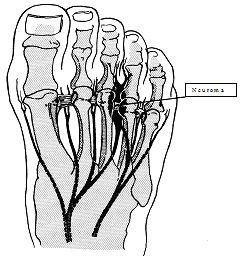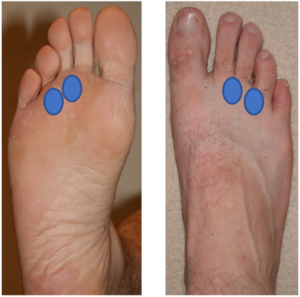
Mr Paul Hamilton
Specialist expertise: Foot and Ankle Conditions, Orthopaedics, Sports Injuries, Upper and Lower Limb Tendon Injuries, Foot & Ankle, Bunions, Arthritis, Foot Surgery, Shockwave Therapy, Morton's Neuroma.
Do you feel like you are walking on pebbles, with sharp pain or pins and needles in the ball of your foot or your toes? Could it be a Morton’s neuroma? If it is, what can you do about it? In this article, Paul Hamilton, Consultant Orthopaedic Surgeon, describes what a neuroma is, what it feels like to have one, what causes it and the common treatments that are available.

A Morton’s neuroma is one cause of metatarsalgia, a condition that causes pain in the ball of the foot. This pain is due to inflammation and subsequent thickening of the tissue that surrounds one of the nerves leading to the toes. The inflammation may be caused by irritation, trauma or increased loading of the nerve underneath the bones of the ball of the foot.
‘Neuroma’ means nerve tumour. ‘Tumour’ in this case simply means enlargement of the nerve and does not relate to a malignancy or cancer. Neuromas are often associated with inflammation of small fluid filled sacs (bursitis) that are present in the foot and act as cushions.

Figure 1. A neuroma between the third and fourth metatarsal heads.

Figure 2. The blue circle indicates common places where pain is felt with a neuroma.
The symptoms of a neuroma are usually pain in the ball of the foot (often termed metatarsalgia) that can shoot down the toes and occasionally cause numbness in the toes. At times, the pain may be absent; at other times, however, it can be severe enough to cause the individual to stop and take off their shoes. Having a Morton’s neuroma can feel like walking on a marble or stone. Tight shoes, high heels and pushing off the starting blocks when running can aggravate the symptoms.
The diagnosis of the neuroma can sometimes be made based on the description of the symptoms, but diagnosing neuroma can prove challenging. The examining doctor can sometimes feel a neuroma by pressing on the foot. Callosities (hard skin) under the foot and toe deformity (clawing or elevation of the toe off the ground) make the diagnosis more difficult. If there is any doubt about the diagnosis, further review by an orthopaedic surgeon specialising in foot and ankle surgery is recommended prior to treatment.
X-rays can help rule out other diagnoses, but neuromas cannot be seen on an x-ray. Ultrasound is a useful diagnostic investigation that can confirm the presence of a neuroma; however, it may be that the neuroma is an incidental finding and may not be the underlying cause of the pain. MRI scans can confirm the diagnosis and are often used to rule out other causes of pain.
Treatments that reduce the inflammation and load in the forefoot can allow neuromas to become asymptomatic, i.e. cause no pain. It is recommended that suffers of Morton’s neuroma try conservative treatments prior to undergoing surgical treatment. Such conservative treatments include the following:
Application of ice on the inflamed area
Physical therapy exercises, i.e. stretching and massages
Orthotics (splints and braces) and shoes
Initial treatment should be non-operative and aim to reduce inflammation and the load across the foot. Such treatments can be successful in up to 80% of cases and may include:
A short course of anti-inflammatories
Calf stretches to reduce the forefoot pressure
Wide-fitting shoes to prevent compression of the nerve
Custom insoles that combine a medial arch and metatarsal dome to reduce the pressure on the nerve
A steroid injection which can be done under ultrasound guidance
If conservative treatment fails, surgery can be considered. Surgical operations aim to remove the nerve and thus relieve the pain. Since a nerve is removed, there will be permanent numbness in part of the toe that is affected by the surgery. This is not usually a problem, and it becomes less of a problem with time. The surgery is usually performed under a combination of general and local anaesthetic, and you can go home on the same day.
The foot is bandaged for two weeks; although you can walk immediately, it is recommended that you elevate the leg as much as possible for the first two weeks. It is common for some residual discomfort and swelling to last for several months, and impact activities, such as running. should be avoided for at least six weeks.
Here at OneWelbeck, we have a team of specialists, state of the art facilities and diagnostics, and highly competitive financial packages for self-funding patients as well as those with private health care.
OrthopaedicsMr Paul Hamilton is an Orthopaedic Surgeon at OneWelbeck Orthopaedics. Mr Paul Hamilton leads a foot and ankle sports injury and heel pain clinic, and also sets up and runs a diabetic multi-disciplinary foot clinic.